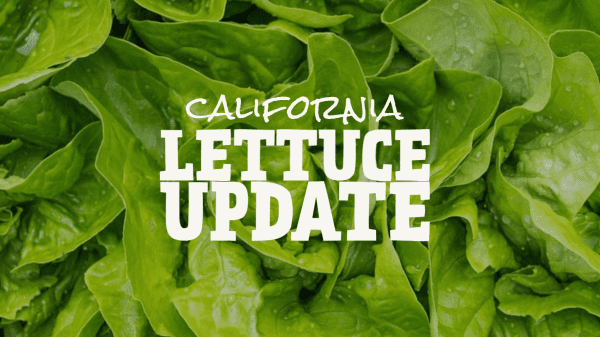
Prices on many leaf and lettuce items from the Salinas, CA, area keep rising for a variety of reasons from bad weather to soil diseases to strong demand.
According to USDA’s Agricultural Marketing Service, F.O.B.s from Salinas Oct. 15 were in the high $20s for film-wrapped cartons of 24s of iceberg lettuce, and romaine was in the low $40s for cartons of 24s.
According to foodservice cooperative Markon BB #:123315, the situation should continue through the rest of October.
“Green leaf and romaine prices continue to rise,” it reported on its website. “Supplies are extremely limited. Demand remains extremely strong. Industry volume continues to be heavily impacted by the soilborne diseases Sclerotinia and Impatiens Necrotic Spot Virus that are reducing harvestable heads at the field level.”
It also alerted buyers that another warming trend could further affect supplies.
California’s Central Coast growing regions are experiencing yet another warming trend that will continue through the rest of this week and impact broccoli, lettuce/leaf, and strawberries, among other row crops.
With little or no marine layer in the forecast, coastal temperatures will see anywhere from 12-20 degrees above normal through Friday, October 16, but onshore flow brings them back to the 70s by Sunday afternoon.
Salinas
Broccoli may see prolonged challenges with pin rot and hollow core as well as decreased yields. Lettuce items may develop internal burn, long core/seeder, rib blight, and sun scalding. Harvesting crews are adjusting production hours to avoid peak temperatures (harvesting earlier in the morning).
Expect tight supplies on most Salinas Valley vegetable crops through the remainder of the season.
Santa Maria
Higher temperatures are causing quality concerns in strawberries such as bruising, decay, small size, and soft fruit.
Harvesting crews are adjusting production hours to avoid peak temperatures and will be culling out as much overripe, soft and crooked fruit as they can over the next 10 days.
Strawberries are coloring up at a fast rate than they are growing due to the heat, resulting in smaller size.
Expect tight strawberry supplies and shortened shelf life for the next 2 weeks.
Prices on many leaf and lettuce items from the Salinas, CA, area keep rising for a variety of reasons from bad weather to soil diseases to strong demand.
According to USDA’s Agricultural Marketing Service, F.O.B.s from Salinas Oct. 15 were in the high $20s for film-wrapped cartons of 24s of iceberg lettuce, and romaine was in the low $40s for cartons of 24s.
According to foodservice cooperative Markon BB #:123315, the situation should continue through the rest of October.
“Green leaf and romaine prices continue to rise,” it reported on its website. “Supplies are extremely limited. Demand remains extremely strong. Industry volume continues to be heavily impacted by the soilborne diseases Sclerotinia and Impatiens Necrotic Spot Virus that are reducing harvestable heads at the field level.”
It also alerted buyers that another warming trend could further affect supplies.
California’s Central Coast growing regions are experiencing yet another warming trend that will continue through the rest of this week and impact broccoli, lettuce/leaf, and strawberries, among other row crops.
With little or no marine layer in the forecast, coastal temperatures will see anywhere from 12-20 degrees above normal through Friday, October 16, but onshore flow brings them back to the 70s by Sunday afternoon.
Salinas
Broccoli may see prolonged challenges with pin rot and hollow core as well as decreased yields. Lettuce items may develop internal burn, long core/seeder, rib blight, and sun scalding. Harvesting crews are adjusting production hours to avoid peak temperatures (harvesting earlier in the morning).
Expect tight supplies on most Salinas Valley vegetable crops through the remainder of the season.
Santa Maria
Higher temperatures are causing quality concerns in strawberries such as bruising, decay, small size, and soft fruit.
Harvesting crews are adjusting production hours to avoid peak temperatures and will be culling out as much overripe, soft and crooked fruit as they can over the next 10 days.
Strawberries are coloring up at a fast rate than they are growing due to the heat, resulting in smaller size.
Expect tight strawberry supplies and shortened shelf life for the next 2 weeks.
Greg Johnson is Director of Media Development for Blue Book Services



